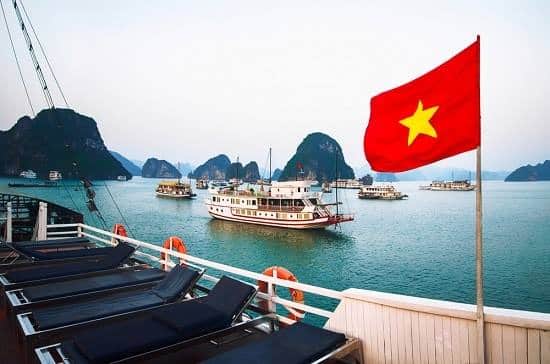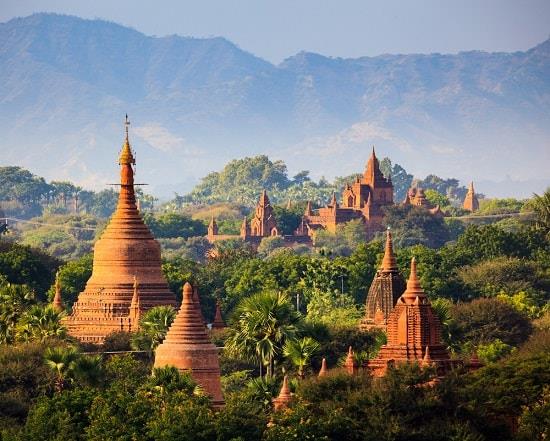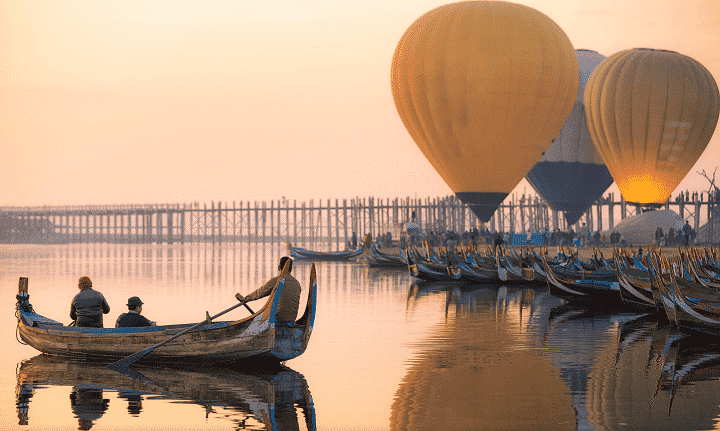BAGAN HOLIDAYS & TOURS
Bagan tours attractions welcoming you to the ancient city of Myanmar, and is famous for being home to over 2000 Buddhist temples and pagodas. Bagan is divided into three parts, Old Bagan, New Bagan and Nyaung U. The majority of the temples and pagodas are scattered throughout Old Bagan. Shwezigon Paya is the oldest temple in Bagan district, which was also the only one constructed by stones. Ananda Pahto is the most exquisite temple housing the most solemn figure of Buddha.
No visit to Bagan is complete without enjoying the sunrise or sunset at Shwesandaw Paya, alternatively, a cruise along the Irrawaddy River is also a great opportunity to enjoy sunset and admire the stunning scenery along the river.
The up and coming areas of Nyaung U and New Bagan are bustling and thriving on new development, and it is here that you will find a variety of different restaurants, guesthouses, and souvenir shops.
bagan at a glance
Time difference: GMT + 6.5 hours
Visa Required: Yes
Currency: Kyat
Tel Code: +95
Official Language: Burmese
Main Religion: Theravada Buddhism
Airlines: Thai Airways, Cathay Pacific, Vietnam Airlines, Singapore Airlines, Malaysia Airlines
Things To See In Bagan
A guided tour to discover Burma’s central plains have hosted many old kingdoms. The legacy of these kingdoms is one of Burma’s most spectacular sights, an expanse strewn with temples of all shapes and sizes. There isn’t time to see them all but you can certainly see the best and these are the ones that we recommend. Two days is a good amount of time to explore.
This bewildering, deserted city of fabulous pagodas and temples on the banks of the Ayeyarwady is one of the wonders of Asia. Bagan travel and tours introduce you with grandeur stretched from the 11th to the 13th centuries, and an enormous number of magnificent buildings were constructed here. The city was sacked by Kublai Khan in 1287 and never rebuilt. There are some 5000 temples, the most interesting of which are Ananda, Thatbyinnyu and Gawdawpalin.
Shwezigon Pagoda; One of Burma’s most sacred buildings and said to be the stupa on which many later stupas, including Shwedagon in Rangoon, are modelled. Constructed in the 11th century on a site that legend tells a white elephant chose, it was built soon after Buddhism arrived in Bagan, to house a number of sacred Buddha relics. Today it is gilded with gold and surrounded by a complex of fascinating shrines and temple buildings.
Htilominlo Pagoda; Built between 1211 and 1231 during the reign of King Htilominlo, Htilominlo is a red brick mammoth of temple towering to 46 metres tall. It was once completely covered in white stucco and elaborate plaster moldings, some of which you can still see today. Inside Htilominlo you’ll find many small Buddhas enshrined in arched recesses as well as beautiful, colourful murals and frescos of Buddha, many of which are still in reasonable condition.
Ananda Pagoda; Built in the year 1091, Ananda is Bagan’s best known, largest and most beautiful temple. Stories say that its builder, King Kyanzittha, met 8 monks who told him about legendary Nanadamula Cave in the Himalayas and Ananda is his attempt to recreate what he heard. Distinguishable due to its golden spire, Ananda is particularly important due to the four magnificent Buddha images that reside within it. The temple is still in constant use today.
Shwesandaw; Best known as a sunrise or sunset viewing spot in Bagan, come here out of these hours and you’ll have this delightful pagoda to yourself. Believed to have been built in the year 1057 this pagoda, along with 4 others, is believed to give Bagan spiritual protection. The name means ‘golden holy hair’ and it’s thought that it enshrines a Buddha relic – a strand of hair. This circular structure has five levels of terraces, each giving a better and better view over the plains.
Thatbyinnyu Temple; Towering over many of the surrounding monuments, Thatbyinnyu is a 60-metre-tall two level temple. Built in the mid-12th century and said to be of a transitional style between Early Style and Late Style buildings, Thatbyinnyu is home to a large number of seated Buddhas, whilst on the second level is a huge Buddha image sat on a throne. The terrace is a good place to head for views out over the plains to the Irrawaddy River beyond.
Mt Popa; Not part of Bagan but close by and well worth a visit, Mt Popa is an extinct volcano that rises 1,518 metres out of the Myingyan Plain. It is the spiritual home of the 37 nats, part of the Burma’s pre-Buddhist animist religion and a much-visited pilgrimage spot. It’s most impressive feature is the sheer volcanic plug roughly half way up the the summit that is topped by a Buddhist temple which can be reached by climbing 777 steps. Watch out for the macaques!
top holidays tours visiting bagan
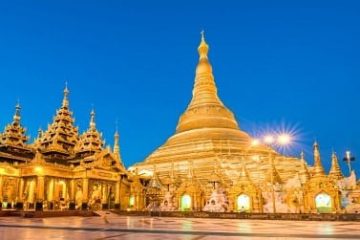
Myanmar Absolute Tours
A 7 day private holiday visiting Yangon, Bagan, Mandalay, Inle Lake with lots of local experience, tour start and end in Yangon, the largest city of Myanmar

Myanmar Impression Tours
A 6 day itinerary that allow you to visit best of Burma (Myanmar), explore fascinating landscapes, ancient history and learn about the local culture with welcoming folks
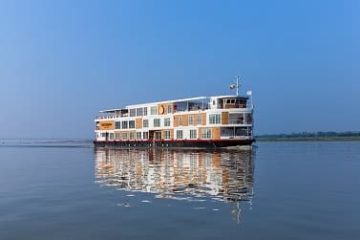
Burma Irrawaddy Voyager
The Irrawaddy River is a 11 day cruise voyager to experience a side of the country that many have yet to explore from the comfort of an elegant cruise boat, sailing from Mandalay to Bagan.

Myanmar Luxury Tours
Travel to mysterious Myanmar on a Myanmar luxury tour which allow you to explore amazing sites and ancient attractions as well as an exciting balloon tour over the Bagan valley with amazing sunset cruise.
INTERESTING THINGS TO DO IN BAGAN
Rent Electric scooter in Bagan
The first thing to do in Bagan is to find a transportation method to visit the hundreds of temples. You can book a tour to visit Bagan, seat back and enjoy, Or, choose to rent an electric motorcycle, that could be fun and a bit of a practical option. You can rent scooter from your hotel which costs about $ 7 a day and you will have complete freedom to tour Bagan on your own. The only drawback are the dusty / sandy roads: you will arrive at the hotel covered in dust. Make sure you to fully charge the electric bike’s battery so you do not stuck halfway. If you want to go more comfortable you can hire a car with driver for about $ 35 a day. In addition to transportation, you will have the advice of a local guide while touring Bagan valley.
Bagan sunrise on hot air balloon
One of the most special things to do in Bagan is to watch the sunrise from above and with a bird view. Flying over the temples while the sky is dyed orange could be magical. Yes, magic has a pretty high price. A balloon flight costs around € 300 per person including transportation and breakfast. You can book it in advance through to ease the hassle once in the country. The balloons only fly between October and April, when the temperature is lower and the winds are less strong.
NOTE: It’s quite cold in Bagan early in the morning and once the sun goes down. Therefore, it is advisable to wear a jacket whether you fly in a balloon or if you stay on land contemplating the show.
Visit extensive Ananda temple
Ananda is one of the most popular temples to see in Bagan. It was originally created in the year 1090, but it was completely rebuilt after the earthquake of 1975. Its large size and light colored stone attract a lot of attention. There are 4 Buddha statues of about 10 meters high inside the Ananda temple. It is very accessible by the main road, so there are usually many people if you do not visit it in the first hour. To enter (or climb) any temple in Bagan you must take off your shoes and socks. In addition, the clothes must cover shoulders and knees.
Witness the Ananda festival in January
If you’re visiting Bagan in January, you may be lucky enough to witness the Ananda temple festival. It lasts a week, which becomes a whole party. Dozens of vendors set up their stops in front of the temple while the monks sing various sacred texts for 72 hours without stopping. The highlight of the festival is the night of the full moon, when thousands of pilgrims make offerings to the monks.
The ancient Thatbyinnyu temple
Not far from the Ananda, there is other majestic temple called Thatbyinnyu. It is the highest in Bagan with a central tower 61 meters high. It was the first temple of two floors and is one of the most visited. If you enter the roads around you will find small pagodas from where to see the temple surrounded by balloons at dawn.

North Guni and its surroundings
Near Sulamani there is a medium sized temple that everyone love to see it. The temple is very beautiful and it is also an ideal place to contemplate the balloons at dawn. It is no longer allowed to climb the roof, but next door there is a field with great views.

Learn more in archaeological museum of Bagan
The archaeological museum of Bagan is a good visit in order to learn more the history of its temples. There you can see a lot of relics taken from the temples: Buddhas, statues, inscriptions and other historical objects. The entrance costs 5000 kyats (about € 3). It’s okay to spend a couple of hours taking shelter from the suffocating heat.
It is worth spending several days in Bagan to fully appreciate the scale and grandeur of the temple landscape and discover the surrounding countryside and nearby towns. One of our favourite activities is exploring the west bank of the Ayeyarwady, an area rarely visited. Take a 4×4 tour of rural villages where cane and cotton weaving are common and visit the 11th century Taunt Kyi Taung Pagoda. Built by King Anawrahta, Taunt Kyi Taung is the final stop on a local pilgrimage trail. Legend has it that the king was given a replica of Buddha’s holy tooth and advised to enshrine it in a pagoda so that it could be worshipped by all. He placed the relic on the back of his precious white elephant and set it free, promising to build a pagoda at each of the elephant’s resting places. Pilgrims still believe that if you pay homage at all four pagodas on the trail before noon, your wish will be fulfilled. The flat plains of Bagan are easy to tour by bicycle and this is a very pleasant and relaxing way to get off the beaten track. It is possible to visit a traditional village and have lunch with a local family to learn more about everyday life here. Bagan is the home of Burma’s lacquerware trade and you can visit workshops to see this intricate and time-consuming process at first hand.
Copyright 2013-2017 Vietnamese Private Tours Ltd With Vietnam Luxury Travel

